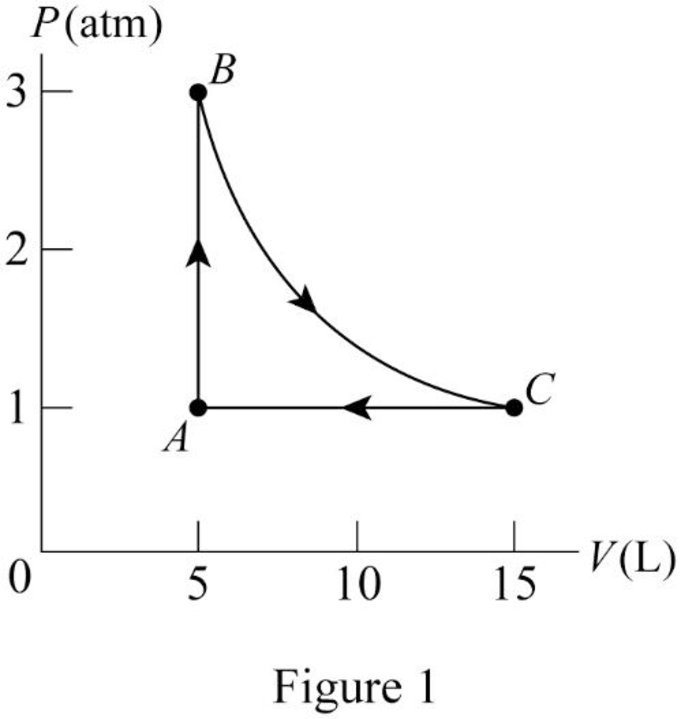
A sample of a monatomic ideal gas occupies 5.00 L at atmospheric pressure and 300 K (point A in Fig. P17.68). It is warmed at constant volume to 3.00 atm (point B). Then it is allowed to expand isothermally to 1.00 atm (point C) and at last compressed isobarically to its original state. (a) Find the number of moles in the sample. Find (b) the temperature at point B, (c) the temperature at point C, and (d) the volume at point C. (e) Now consider the processes A → B, B → C, and C → A. Describe how to carry out each process experimentally. (f) Find Q, W, and ΔEint for each of the processes. (g) For the whole cycle A → B → C → A, find Q, W, and ΔEint.
Figure P17.68

(a)
Thenumber of mole in the sample.
Answer to Problem 68P
Thenumber of mole in the sample is
Explanation of Solution
Write the expression for theideal gas law,
Here,
Rewrite the above equation,
Conclusion:
Substitute
Therefore, the number of mole in the sample is
(b)
The temperature of the sample at point
Answer to Problem 68P
The temperature of the sample at point
Explanation of Solution
Write the expression for thetemperature of the sample at point
Here,
Conclusion:
Substitute
Therefore, the temperature of the sample at point
(c)
The temperature of the sample at point
Answer to Problem 68P
The temperature of the sample at point
Explanation of Solution
Write the expression for thetemperature of the sample at point
Here,
Conclusion:
Substitute
Therefore, the temperature of the sample at point
(d)
The volume of the sample at point
Answer to Problem 68P
The volume of the sample at point
Explanation of Solution
Write the expression for thevolume of the sample at point
Here,
Conclusion:
Substitute
Therefore, the volume of the sample at point
(e)
Explain the processes
Answer to Problem 68P
In the process
In the process
In the process
Explanation of Solution
In the process
Lock the piston in place and put the cylinder into an oven at the temperature of
Here the gas is getting heat gradually.
In the process
The sample is keep in the oven while the gas expand gradually and to lift a load on the piston as far as it can.
In the process
The cylinder is carry and back into the room temperature at
Here the gas is cooling gradually and contract without touching the piston.

Conclusion:
Therefore, in the process
In the process
In the process
(f)
The value of
Answer to Problem 68P
The value of
Explanation of Solution
For
Write the expression for theenergy transferred by heat,
Here,
Write the expression for the change in internal energy,
In this case,
For
Write the expression for the work done on the sample,
In this case,
For
Write the expression for the work done on the sample,
Conclusion:
Substitute
Substitute
Substitute
Substitute
Substitute
Substitute
Substitute
Therefore, the value of
(g)
The value of
Answer to Problem 68P
The values of
Explanation of Solution
Write the expression for theenergy transferred by heat in the whole process
Write the expression for the work done for whole process,
Write the expression for the change in internal energy for whole process,
Conclusion:
Substitute
Substitute
Substitute
Therefore, the values of
Want to see more full solutions like this?
Chapter 17 Solutions
Principles of Physics: A Calculus-Based Text, Hybrid (with Enhanced WebAssign Printed Access Card)
- look at answer show all work step by steparrow_forwardLook at the answer and please show all work step by steparrow_forward3. As a woman, who's eyes are h = 1.5 m above the ground, looks down the road sees a tree with height H = 9.0 m. Below the tree is what appears to be a reflection of the tree. The observation of this apparent reflection gives the illusion of water on the roadway. This effect is commonly called a mirage. Use the results of questions 1 and 2 and the principle of ray reversibility to analyze the diagram below. Assume that light leaving the top of the tree bends toward the horizontal until it just grazes ground level. After that, the ray bends upward eventually reaching the woman's eyes. The woman interprets this incoming light as if it came from an image of the tree. Determine the size, H', of the image. (Answer 8.8 m) please show all work step by steparrow_forward
 Physics for Scientists and Engineers, Technology ...PhysicsISBN:9781305116399Author:Raymond A. Serway, John W. JewettPublisher:Cengage Learning
Physics for Scientists and Engineers, Technology ...PhysicsISBN:9781305116399Author:Raymond A. Serway, John W. JewettPublisher:Cengage Learning Principles of Physics: A Calculus-Based TextPhysicsISBN:9781133104261Author:Raymond A. Serway, John W. JewettPublisher:Cengage Learning
Principles of Physics: A Calculus-Based TextPhysicsISBN:9781133104261Author:Raymond A. Serway, John W. JewettPublisher:Cengage Learning Physics for Scientists and Engineers: Foundations...PhysicsISBN:9781133939146Author:Katz, Debora M.Publisher:Cengage Learning
Physics for Scientists and Engineers: Foundations...PhysicsISBN:9781133939146Author:Katz, Debora M.Publisher:Cengage Learning
 College PhysicsPhysicsISBN:9781285737027Author:Raymond A. Serway, Chris VuillePublisher:Cengage Learning
College PhysicsPhysicsISBN:9781285737027Author:Raymond A. Serway, Chris VuillePublisher:Cengage Learning




